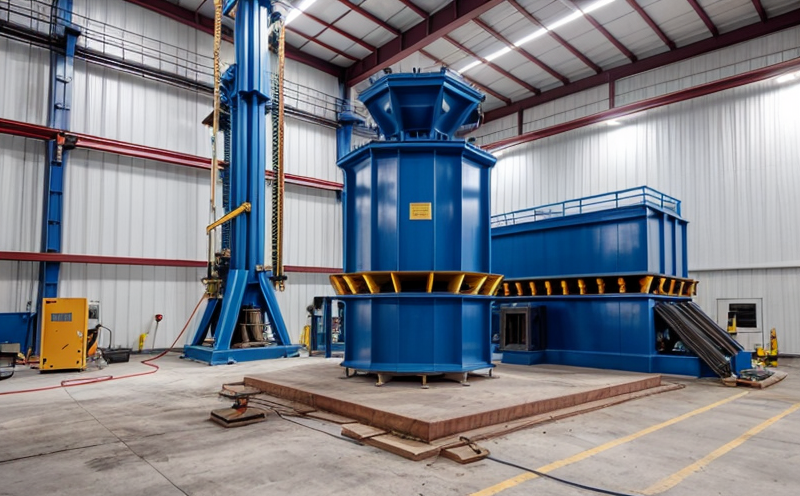Structural Vibration & Modal Analysis Testing
The field of structural vibration and modal analysis testing is paramount in ensuring the reliability, durability, and safety of various engineered systems. These tests are crucial for industries ranging from automotive to aerospace, where components must withstand extreme conditions without failure.
Modal analysis focuses on identifying the natural frequencies, damping ratios, and mode shapes of a structure under specific boundary conditions. It provides insights into how structures will behave under dynamic loading, helping engineers predict potential issues before they occur in real-world applications. Vibration testing, conversely, involves applying controlled forces to simulate operational environments and assess performance parameters such as resonance, fatigue life, and stress levels.
Understanding the modal characteristics of a structure is essential for optimizing design parameters like mass distribution or material selection. Modal analysis can also help identify areas prone to excessive vibration that may lead to structural damage over time. In contrast, vibration testing ensures that products meet regulatory standards regarding noise reduction, comfort enhancement, and overall performance under operational conditions.
The process typically begins with detailed specimen preparation tailored to the specific requirements of each project. This includes cleaning surfaces, applying appropriate lubricants if necessary, and ensuring all fasteners are correctly installed. Once prepared, specimens undergo rigorous testing using advanced equipment such as shakers, force transducers, accelerometers, and displacement sensors.
Following data collection, sophisticated software packages analyze the acquired information to produce comprehensive reports detailing modal parameters and vibration spectra. These outputs serve as critical references for further development efforts aimed at improving product quality and reducing manufacturing costs through informed decision-making processes based on empirical evidence rather than conjecture alone.
By leveraging these techniques early in the design cycle, manufacturers can significantly reduce risks associated with unexpected failures during service life cycles. Additionally, they gain valuable insights into material behavior under varying conditions which contributes towards creating more efficient designs overall.
Benefits
Implementing structural vibration and modal analysis offers numerous advantages across multiple sectors including automotive manufacturing, aerospace engineering, construction, and consumer electronics. For instance:
- Enhanced Reliability: Identifying weak points in structures early allows manufacturers to address issues before they become critical problems.
- Faster Development Cycles: By incorporating test results into design iterations, companies can accelerate time-to-market without compromising on quality standards.
- Cost Savings: Early identification of potential defects translates directly into reduced warranty claims and repair expenses later down the line.
- Better Compliance: Ensuring that products meet relevant industry regulations enhances brand reputation while avoiding costly penalties for non-compliance.
In summary, integrating structural vibration and modal analysis into product development workflows leads to higher quality outputs and greater customer satisfaction. It enables firms to stay competitive in today’s fast-paced market environment by delivering superior goods at affordable prices.
Customer Impact and Satisfaction
The implementation of structural vibration and modal analysis has far-reaching implications for customers seeking high-quality products that meet stringent performance expectations. Here are some ways this testing methodology positively influences customer experience:
- Increased Product Lifespan: Identifying inherent flaws during early stages ensures that final products last longer without experiencing premature failures.
- Better User Experience: Products designed with these tests in mind tend to offer smoother operation, reduced noise levels, and enhanced comfort for users.
- Improved Safety Standards: Ensuring compliance with applicable safety norms protects both consumers and end-users from harm due to substandard components or assembly methods.
- Enhanced Reputation: Demonstrating commitment to excellence through thorough testing improves brand perception among potential buyers who value reliability above all else.
Ultimately, by focusing on these aspects, businesses not only satisfy existing clients but also attract new ones looking for trustworthy partners committed to delivering top-notch solutions tailored specifically for their needs.
Environmental and Sustainability Contributions
- Energy Efficiency: Optimizing designs through modal analysis helps minimize weight and size, thereby reducing fuel consumption in vehicles or energy usage in buildings.
- Material Optimization: Identifying optimal materials for specific applications reduces waste throughout production processes while maintaining structural integrity.
- Reduced Noise Pollution: Minimizing vibrations during operation decreases noise emissions contributing to healthier living environments and better air quality.
- Innovation in Recycling: Understanding how components degrade over time encourages the development of more sustainable materials that can be easily recycled at end-of-life stages.
By adopting such practices, companies contribute positively towards global efforts aimed at combating climate change. They also demonstrate corporate responsibility by prioritizing long-term sustainability goals alongside short-term profitability targets.





